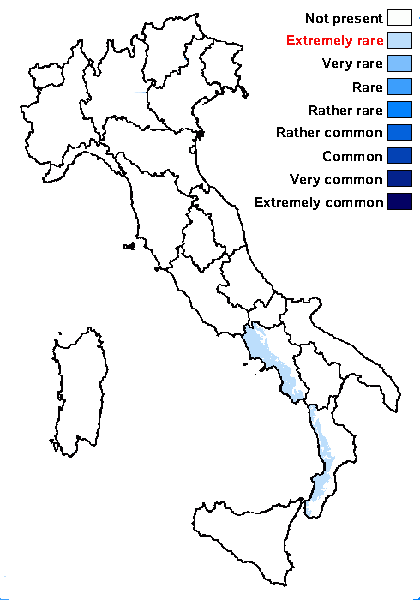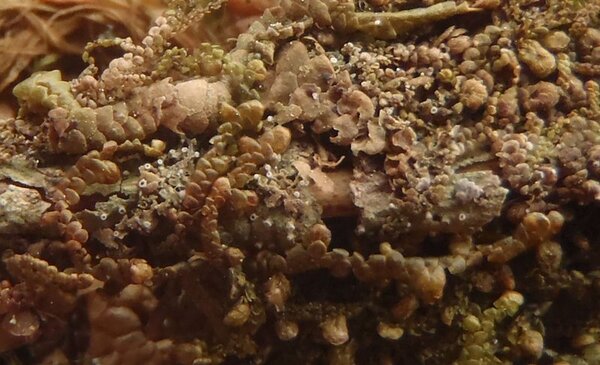Byssoloma marginatum (Arnold) Sérus.
in Coppins & al., Lichenologist, 24: 367, 1992. Basionym: Bilimbia marginata Arnold - Flora, 47: 598, 1864.
Synonyms: Bacidia marginata (Arnold) Lettau; Tapellaria similis Kalb
Distribution: S - Camp (CLU 10319), Cal (Puntillo & Vezda 1994, Sérusiaux 1996, 1998, Puntillo 1996, 2000, Nimis & Tretiach 2004).
Description: Thallus crustose, thinly episubstratic, usually continuous, farinose or of dispersed granules, whitish to greenish, forming 1-3(-5) mm wide patches, without a distinct prothallus. Apothecia biatorine, rounded, constricted at base, sometimes confluent into sublobate clusters, 0.3-0.7 mm across, with a flat to strongly convex, purplish brown to bluish-black disc, and a pale grey, slightly raised proper margin, without a distinct byssoid margin. Exciple colourless, with a compact appearance due to a gelatinous matrix embedding the hyphae, without crystals; epithecium colourless to brownish; hymenium colourless, 30-40 µm high; paraphyses simple or sparingly branched, the apical cells not swollen; hypothecium orange-brown, K+ purple-brown. Asci 8-spored, clavate, with a K/I+ blue apical dome containing a darker blue, tubular ring-structure, and an amyloid coat, Byssoloma-type. Ascospores 3-septate, hyaline, ellipsoid, 12-18 x 3-5 µm. Pycnidia subglobose to pyriform, brown. Conidia biclavate to obpyriform, 3.5-4.5 x 1-1.5 µm. Photobiont chlorococcoid. Spot tests: thallus K-, C-, KC-, P-, UV-. Chemistry: thallus without lichen substances.Note: a humid subtropical to mild-temperate lichen growing both on bark and on needles of conifers in warm-humid areas. It is included in the Italian red list of epiphytic lichens as “Endangered” (Nascimbene & al. 2013c).
Growth form: Crustose
Substrata: bark and leaves
Photobiont: green algae other than Trentepohlia
Reproductive strategy: mainly sexual
Restricted to humid-warm, oceanic areas
Commonnes-rarity: (info)
Alpine belt: absent
Subalpine belt: absent
Oromediterranean belt: absent
Montane belt: absent
Submediterranean belt: absent
Padanian area: absent
Humid submediterranean belt: extremely rare
Humid mediterranean belt: extremely rare
Dry mediterranean belt: absent

Predictive model
Herbarium samples
Growth form: Crustose
Substrata: bark and leaves
Photobiont: green algae other than Trentepohlia
Reproductive strategy: mainly sexual
Restricted to humid-warm, oceanic areas
Commonnes-rarity: (info)
Alpine belt: absent
Subalpine belt: absent
Oromediterranean belt: absent
Montane belt: absent
Submediterranean belt: absent
Padanian area: absent
Humid submediterranean belt: extremely rare
Humid mediterranean belt: extremely rare
Dry mediterranean belt: absent

Predictive model
| Herbarium samples |
 INDEX FUNGORUM
INDEX FUNGORUM
 GBIF
GBIF




